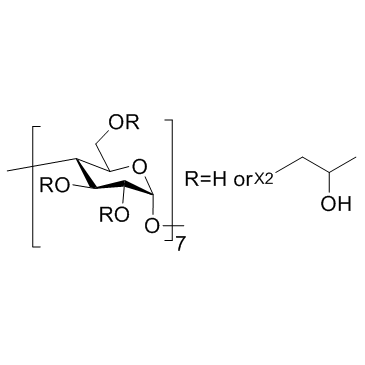128446-35-5
| Name | (2-Hydroxypropyl)-β-cyclodextrin |
|---|---|
| Synonyms |
(2-Hydroxypropyl)-Beta-Cyclodextrin
EINECS 420-920-1 MFCD00069372 Hydroxypropyl-beta-cyclodextrin (2-HYDROXYPROPYL)-β-CYCLODEXTRIN (2-Hydroxypropyl)-Beta-Cyclodextri Hydroxypropyl-β-cyclodextrin |
| Description | (2-Hydroxypropyl)-β-cyclodextrin is a widely used drug delivery vehicle to improve the stability and bioavailability. |
|---|---|
| Related Catalog | |
| In Vitro | Cell treatment with (2-Hydroxypropyl)-β-cyclodextrin results in the activation of the transcription factor EB, a master regulator of lysosomal function and autophagy, and in enhancement of the cellular autophagic clearance capacity[1]. (2-Hydroxypropyl)-β-cyclodextrin treatment reduces intracellular cholesterol resulting in significant leukemic cell growth inhibition through G2/M cell-cycle arrest and apoptosis. The IC50 values for (2-Hydroxypropyl)-β-cyclodextrin after 72 hours exposure are in the range of 3.86–10.09 mM. (2-Hydroxypropyl)-β-cyclodextrin also shows anticancer effects against CML cells expressing a T315I BCR-ABL mutation (that confers resistance to most ABL tyrosine kinase inhibitors), and hypoxia-adapted CML cells that have characteristics of leukemic stem cells. In addition, colony forming ability of human primary AML and CML cells is inhibited by (2-Hydroxypropyl)-β-cyclodextrin[2]. |
| In Vivo | (2-Hydroxypropyl)-β-cyclodextrin administration promotes transcription factor EB-mediated clearance of proteolipid aggregates that accumulate due to inefficient activity of the lysosome-autophagy system in cells derived from a patient with a lysosomal storage disorder[1]. Intraperitoneal injection of (2-Hydroxypropyl)-β-cyclodextrin significantly improves survival in leukemia mouse models. Systemic administration of (2-Hydroxypropyl)-β-cyclodextrin to mice has no significant adverse effects[2]. |
| Cell Assay | Cells are incubated with (2-Hydroxypropyl)-β-cyclodextrin at various concentrations (5, 7.5, 10, 15, 20 mM) for 72 hours. Cell viability is assessed using a trypan blue dye exclusion method and cell proliferation is evaluated using a modified methyl-thiazol-diphenyl- tetrazolium (MTT) assay[2]. |
| Animal Admin | Mice: Mice are intraperitoneally injected with 200 μL vehicle (saline) or (2-Hydroxypropyl)-β-cyclodextrin (50 or 150 mM) for 20 consecutive days 3 days after transplantation, and survival is monitored daily. Leukemic cell engraftment is confirmed by detection of GFP-positive cells in the recipient’s BM using flow cytometry[2]. |
| References |
| Density | 1.4±0.1 g/cm3 |
|---|---|
| Boiling Point | 1521.9±60.0 °C at 760 mmHg |
| Melting Point | 278ºC (dec.) |
| Molecular Formula | C63H112O42 |
| Molecular Weight | 1541.538 |
| Flash Point | 874.2±32.9 °C |
| Exact Mass | 1540.662842 |
| PSA | 618.66000 |
| LogP | -6.23 |
| Vapour Pressure | 0.0±0.6 mmHg at 25°C |
| Index of Refraction | 1.545 |
| Storage condition | 2-8°C |
| Water Solubility | H2O: 45 % (w/v) | Soluble in water. |
| Personal Protective Equipment | Eyeshields;Gloves;type N95 (US);type P1 (EN143) respirator filter |
|---|---|
| Safety Phrases | S24/25 |
| RIDADR | NONH for all modes of transport |
| WGK Germany | 3 |
| RTECS | GU2293332 |


